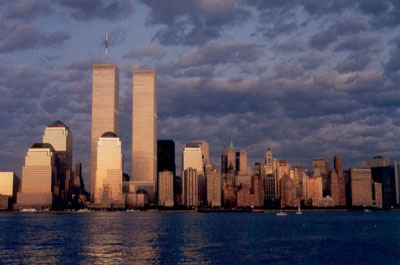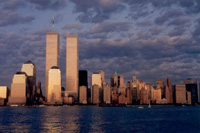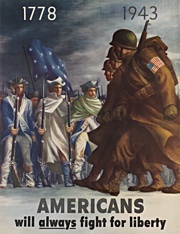Just a quick note to make it official: From now on, I’ll be publishing here at fearlessdream.us.
Anyone who happens to be following my old RSS/Atom feed should get automatically redirected to my new feed URL:
https://fearlessdream.us/feed
I’ve copied all my posts here and mothballed my old Blogger site. The same posts are still online there, to avoid broken links, but I’ve grayed out the site’s theme and added a top-of-page banner directing readers here. (Redirecting individual posts seemed to be more trouble than it was worth.)
I’m looking forward to doing more writing and publishing here, including continuing the No Fear Pioneer podcast. So please do stay tuned — I’m not done yet! :-)
I published the following on September 11th, 2004, on another site I had back then. That site having gone the way of homepage.mac.com, I thought I’d reunite this post with the rest of my 9/11 series.
Plenty has happened in the decade since, and I’m glad to see that we did ultimately rebuild at the World Trade Center site, even as I’m still concerned that it took us as long as it did.
In September 2001, I was living about 110 miles up the Hudson River from New York City. According to published flight path information, American Airlines Flight 11 passed not so very far from overhead on that morning three years ago, on its way toward New York City and its collision with the north tower of the World Trade Center. I visited Ground Zero two weeks after the terrorist attacks, at which time the fence perimeter allowed one to get within two blocks or so of the site — close enough to experience the twisted wreckage of the towers’ remaining outer walls, the debris everywhere, the people working to search for human remains and clear the site, as something undeniably real. And amid the complex knot of feelings that continued to unravel in the sunken pit of my stomach — including the struggle to address the seemingly impossible question of how any human being could be capable of following through on, much less conceiving of such a vicious attack — I also felt, and still very much feel today, a strong conviction about at least one thing: Ultimately, we must rebuild.
Why care so much about putting some new buildings in Lower Manhattan? After all, the catastrophe of that day is over, its victims irreversibly claimed. Nothing we do now can bring them back to us.
I care about what we do to rebuild, because the towers symbolize something positive to me — they were monuments to human progress, to what people in a free and voluntary society are capable of achieving. And I care because I see vital symbolism in the act of rebuilding itself, of finding and enacting a design that not only mourns respectfully “They are gone”, but also affirms with conviction “We are still here.” That our culture is not going away; that we will continue to aspire, dream, strive, design, build, achieve, and live, in many ways, as we have. That we will create our own future rather than accept the fate chosen for us.
But how to rebuild? What to construct in the emptiness where the towers once stood? For me, architect Sherri Tracinski hit on the key issue in her 2002 article written in disappointed response to earlier WTC redevelopment proposals for buildings that fell short of the the Twin Towers’ stature:
Anything less than a new tower at the same height — or higher — is demonstrating to those who hate us that we intend to cut back, roll over, and give up. It is not the quick, violent suicide of putting a gun to your head, but the slow suicide of a man who has given up trying to live.
“Throughout history,” she reminds us, “many great buildings have been damaged and destroyed in war. What a society does to rebuild afterward is an omen for its future survival.” [emphasis mine]
Twenty-five hundred years ago, a marauding Persian army sacked the Greek city of Athens and burned the Parthenon, the city’s most important temple. What did the ancient Athenians do? They didn’t decide they should make a smaller temple so that it would be less of a target in the future. They didn’t decide that they were guilty of offending the enemy with their wealth and success. They didn’t leave a barren plateau to commemorate the men who died fighting the Persians. Instead, after they roundly defeated the enemy, they rebuilt bigger and better.
The old Parthenon had been built of limestone. The new Parthenon was built of the finest material the Athenians could find—white marble—and decorated with inspiring sculptures of heroes. It was the greatest Greek temple ever built and marked the beginning of the Athenian “Golden Age.”
It is in the wake of historic precedents such as this one that we are left to decide what it is that we will do. Will we “cut back” half-heartedly? Or will we summon the will to replace what was taken from us with something still more ambitious? In July, the cornerstone was laid for the first and tallest building now scheduled to be constructed at the site. The planned “Freedom Tower” would, at 1,776 feet, stand taller still than did the 1,362 and 1,368 foot Twin Towers. Yet if the tone and content of last Tuesday’s Frontline report “Sacred Ground” is to be believed, the construction of the tower seems anything but certain — jeopardized by infighting among rival architects Daniel Libeskind and David Childs, developer Larry Silverstein, the Lower Manhattan Development Corporation and the city and state governments of New York. Will we blow it by letting the project become mired in egos and politics? Will we be persuaded that we shouldn’t even care — or maybe, just maybe should even be glad to see the towers gone?
It’s at this point that I struggle to fathom stuff like this. It takes a pretty twisted worldview to attempt to brush aside the viciousness and human toll of September 11th and invoke a phrase like “radical architectural criticism” to describe the deliberate flying of aircraft full of people into buildings full of people. People, some of whom chose to jump to their deaths rather than accept the fate that had been chosen for them. Maus creator Art Spiegelman really ought to know better. And he ought to know all about what life in an actual police state is like. James Lileks takes him deservedly to task, on the eve of publication of Spiegelman’s In the Shadow of No Towers. (There’s no anchor, so you’ll have to scroll to about the bottom third of the page to find the part about Spiegelman. There’s a pointed note about journalism and the recent carnage in Beslan along the way. Link courtesy of Instapundit.)
That’s how Spiegelman would have us feel about the towers, our culture, and ourselves? Thanks, Art. We’ll remember that.
Clearly there is nothing to stop us from succumbing to this kind of thinking if we choose to do so. How we respond, how we move on, is our choice. I’m moved to remember Senator McCain’s words as he declared in his gentle, measured tone, “What our enemies have sought to destroy is beyond their reach. It cannot be taken from us. It can only be surrendered.” And so indeed, it is left up to us to decide what to do next. We can resign ourselves to accept empty footprints and a hole in the sky, or some modest concession, where the towers once stood. Or we can rebuild with determination to reach still greater heights.
Those who perished needlessly in New York, Washington D.C., and Pennsylvania, can never be replaced. But I believe we can best honor their memory by our commitment to keeping our enterprising culture alive and thriving.

What we have built still stands tall in our hearts.
Links
Frederick Turner’s “Honor in the Sky” provides another interesting take on the meaning of rebuilding, and offers the imaginative if maybe not practical (?) idea of placing a garden memorial atop the new building(s).
Team Twin Towers [link broken] hosts a page of comments from survivors and others who would like to see the towers or something like them rebuilt.
Wikipedia:
Another 9/11 has rolled around. And while the grief and anger are still there, and we have renewed cause for concern this year in the rise of ISIS/ISIL, I find that my feelings seem not particularly more pronounced on this day relative to any other. The problems that we are obliged to squarely face endure, and are relevant every day of the year, not just on anniversaries of the September 11th, 2001 Jihadist attacks on the United States.
The sickening brutality of ISIS/ISIL and its ideological fellow travelers such as Boko Haram has been something for the world to behold. If we cannot now see with complete clarity what these scumbags are about, I don’t know what it will take. The fact of things as I see it is that ISIS/ISIL are but a particularly awful symptom, one that is enabled and allowed to exist only to the extent that we lack the resolve to call them what they are and commit ourselves unreservedly to their complete and unconditional defeat.
The broader, underlying problem we face is an erosion of cultural confidence, and I’m sad to say it’s the predictable result of decades of steady, dedicated work by many among us — people whose aim has been to demoralize us and gradually chisel away at the foundations of our belief in who we are and the way that we live. An event such as 9/11 should have brought us to our senses, it seems to me, and brought an end to that idle self-doubt, seemingly born of boredom with years of relative safety and security. But I’ve been proven more wrong in that expectation than in any other of my life. Rather than have a change of heart, our cultural termites dug in and continued their toil. It makes no sense to me to see a culture of great achievement, worthy of celebration and of a strident and confident defense, in such willful and sometimes self-recriminating denial about the threats posed to it. But there it is. It’s an aspect of human nature that I suspect I will continue to struggle to understand for many years to come.
I do feel I’ve made progress, though, in casting off the shadow of gloom this past year and a half or so. It feels as if my thinking has shifted to a point of: OK. So that’s how it is. What are you going to do about it?
Our present condition is not cause to sit in idle resignation. It’s cause to get up, dust ourselves off, and fix the things that matter. And despite all the potential reasons for gloom, I’m doing it with gratitude in my heart, a cheerful demeanor, and a smile on my face — because I’ve learned that no matter what, one cannot allow others to drive him to despair. To have hope of prevailing, we must maintain a steady and undaunted focus on all that is positive in our love for what we hold dear. We must make that love stronger, more resilient, and more lasting than our enemies’ bitterness, brutality, and hate. It’s what I’ve been striving to do, and aim to continue to do, with The No Fear Pioneer (so please give a listen, and stay tuned for more to come).
That’s it for now. As in previous years, I may follow up with some links and quotes later, as I read good work by others. Below are links to my previous years’ 9/11 posts, including the 2009 retelling of my own peripheral but deeply affecting experience of that awful day. As before, I pledge myself never to forget — nor misremember. May we find our way to better times.
My Previous Years’ 9/11 Posts
2013: 9/11, Twelve Years On
2012: 9/11, Eleven Years On
2011: A Plea, Ten Years After: Please, Open Your Eyes ~ Ten Years Later: 9/11 Links
2010: 9/11: Two Songs
2009: Tomorrow is 9/11 ~ My Experience of September 11, 2001 ~ 9/11 Quotes
2008: 9/11, Seven Years On ~ 9/11, Seven Years On, Part 2 ~ 102 Minutes that Changed America
2007: 9/11, Six Years On
2006: Soon, Time Again to Reflect ~ 9/11 Observances ~ 9/11 Observances, Part 2
2005: I Remember
2004: Remembering and Rebuilding (republished here September 12th, 2014)








